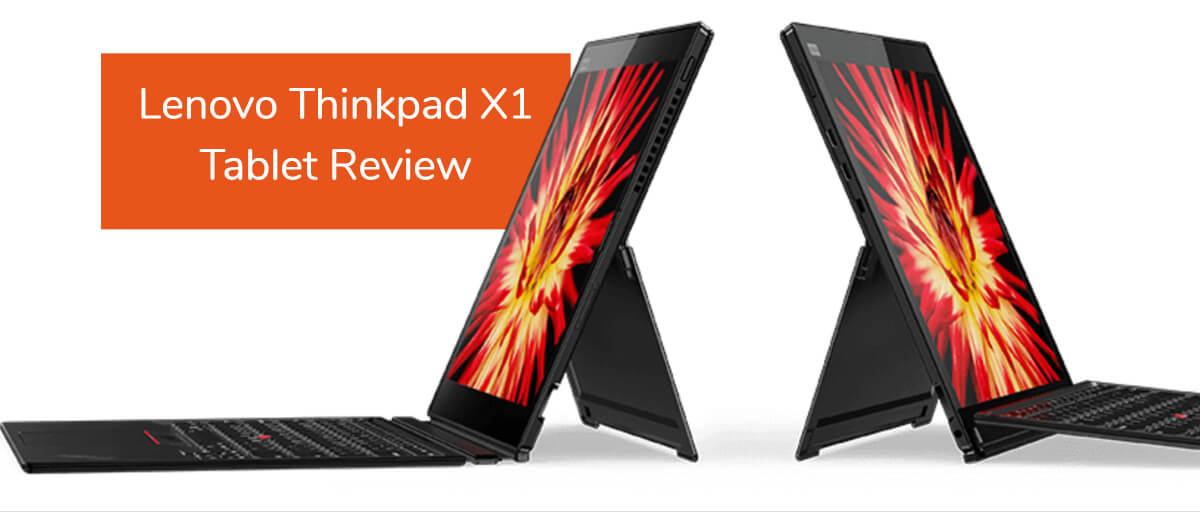Table of Contents
Last Updated on March 29, 2020
First released in 2016, the Lenovo ThinkPad X1 tablet was designed to compete with the likes of the Microsoft Surface Pro 4 and iPad Pro. Unlike the Thinkpad X1 carbon and Yoga laptops, the X1 tablet can be used as a standalone slate, with a detachable keyboard.
This third version of the X1 tablet updates the already popular design, with more power, a superior display and something that its competitors don’t offer yet: USB-C. Is the addition of USB-C and Thunderbolt really enough to tempt you away from your Microsoft Surface?
Specifications
Design
A Gorilla Glass construction with magnesium and aluminum body ensures the X1 is one of the most durable tablets on the market. With the usual Lenovo ruggedness, you have come to expect, the X1 tablet can withstand shock, vibration and environmental extremities, certified to military standards.
X1 and Thinkpad logos can be found on the Matte finished back surface, with an improved kickstand design. Instead of the previous ramp design, it now folds outwards, with Lenovo’s unique hinges being both strong and sturdy.
Display
The 13-inch 3K display found on this tablet is taller than the one on the Microsoft Pro, and also features a higher resolution. A 3,000 x 2,000 resolution is the best in its class, with a dazzling 415 nits brightness. Colors appear vibrant and the images are pin-sharp, with an improved pixel count of 277 PPI.
Eschewing the edge-to-edge design of other manufacturers, the bezel around the screen features an HD 1,920 x 1,080 webcam. The bezel also houses a Windows Hello fingerprint scanner and stereo speakers. Although the screen is great for watching movies, pack a pair of headphones, as the speakers are woefully underpowered.
Keyboard and Pen
Compared to the Surface Pro, the backlit keyboard feels more like a traditional laptop, but with more spacious keys. A red TrackPoint on the keyboard can be used for precision, along with a large trackpad at the base, which supports multi-touch gestures.
The included Active Pen features 4,096 levels of pressure sensitivity, with a solid tip rather than the usual felt tip. Writing or drawing on the screen feels more natural than the Microsoft Surface, with the pen gliding rather than dragging.
Both keyboard and pen are included in the box, with the X1 tablet offering limited functionality without them.
Performance
The new ThinkPad X1 tablets have been upgraded to the latest 8th Gen Intel quad-core processors, with a choice of i5 or i7 chipsets. Three models feature either 8GB or 16GB of RAM, with SSD storage that can be configured up to 1TB.
For use as a business laptop, it’s powerful and fairly robust. Windows 10 Home or Pro comes pre-installed, depending on the model you choose, and can run multiple apps without any hitches.
Although the integrated Intel UHD 620 graphics can handle the enormous display with ease, don’t expect any hardcore gaming.
All this power does come at a cost, however. Battery life is pretty mediocre, at just six to seven hours when used at half brightness. Streaming movies at full brightness, or playing simple games, can significantly drop that figure. Fortunately, you can use any USB-C charger with enough watts to charge the battery.
Ports and Connectivity
Lenovo shines over its nearest rivals with the inclusion of two USB-C Thunderbolt 3 ports. This allows for not only faster data connections, but also more freedom and power options. You could quite easily hook up an external GPU to turn it into a gaming rig. Feel free to attach a 4K monitor or any other peripheral you can think of.
With no HDMI or full-sized USB-A ports, you will have to buy an adapter for older accessories, and rely on docks or hubs for more devices.
A microSD card reader is also included but it is hidden away in a nano sim slot, similar to those found on mobile phones. It’s not ideal as a hot-swappable memory device, as you will need a SIM ejector tool (or paperclip), and it ejects the 4G sim at the same time.
Should You Buy a 3rd Generation Lenovo ThinkPad X1?
This latest generation of the ThinkPad X1 tablet definitely offers more value for your buck than many of its competitors. It’s not cheap, but it does come with keyboard and pen included, plus a larger screen, Amazon Alexa support, and the latest Intel processors.
Extra features, like a fingerprint scanner and IR camera for facial recognition, have brought it ever closer to the Microsoft Surface Pro. In other ways it excels, with its far superior display, more durability, and the added versatility of Thunderbolt 3.
The only things we weren’t impressed with on this tablet were the short 7-hour battery life, and below-par speakers. As long as you can live with these limitations, the ThinkPad X1 tablet offers an ingenious alternative to a high-end laptop, or even a Microsoft Surface Pro.


